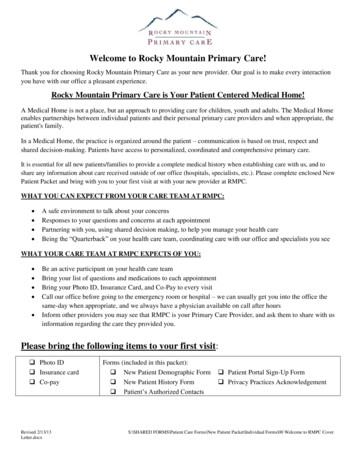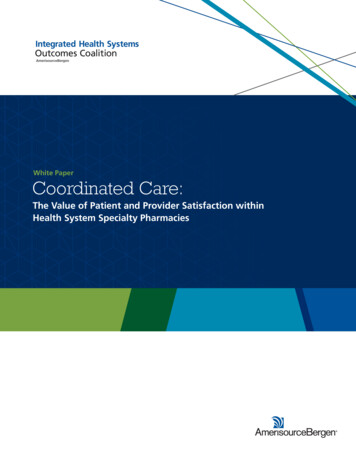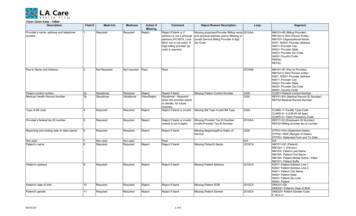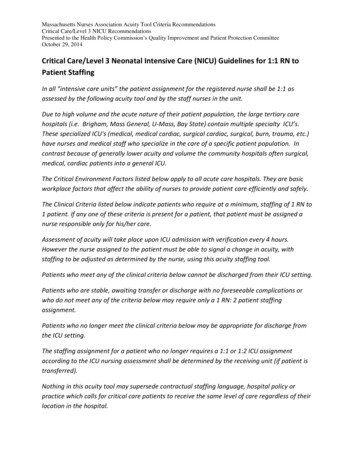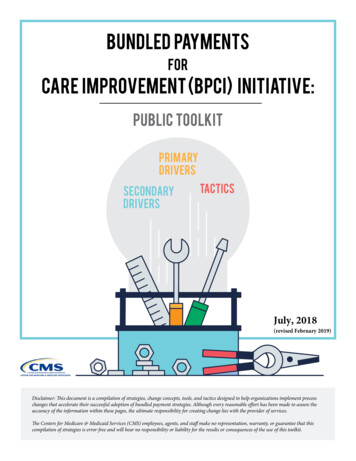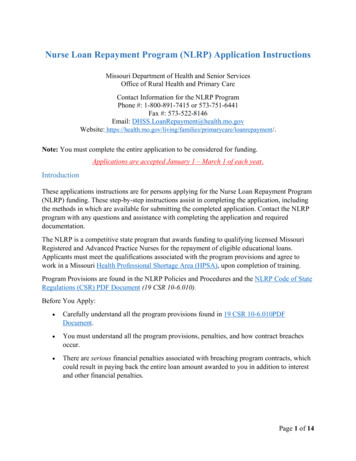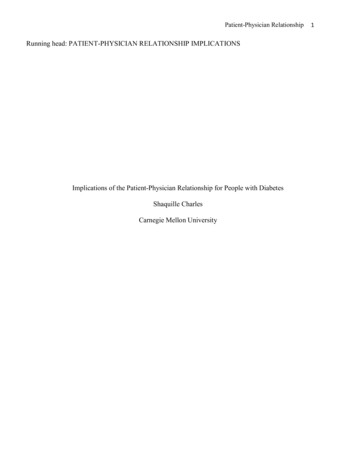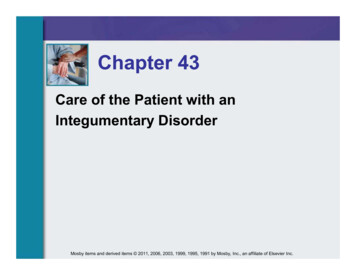
Transcription
Chapter 43Care of the Patient with anIntegumentary DisorderMosby items and derived items 2011, 2006, 2003, 1999, 1995, 1991 by Mosby, Inc., an affiliate of Elsevier Inc.
Overview of Anatomy andPhysiology Functions of the skin ProtectionTemperature regulationVitamin D synthesis Structure of the skin Epidermis The outer layer of the skinNo blood supplyComposed of stratified squamous epitheliumDivided into layers: Stratum germinativum,pigment-containing layer, stratum corneumMosby items and derived items 2011, 2006, 2003, 1999, 1995, 1991 by Mosby, Inc., an affiliate of Elsevier Inc.Slide 2
Basic Structure of the Skin Structure of the skin Dermis “True skin” Contains blood vessels, nerves, oil glands, sweatglands, and hair follicles Subcutaneous layer Connects the skin to the muscles Composed of adipose and loose connective tissueMosby items and derived items 2011, 2006, 2003, 1999, 1995, 1991 by Mosby, Inc., an affiliate of Elsevier Inc.Slide 3
Figure 43-1(From Thibodeau, G.A., Patton, K.T. [2005], The human body in health and disease. [4th ed.]. St. Louis: Mosby.)Structures of the skin.Mosby items and derived items 2011, 2006, 2003, 1999, 1995, 1991 by Mosby, Inc., an affiliate of Elsevier Inc.Slide 4
Basic Structure of the Skin Appendages of the skin Sudoriferous glands—sweat glandsCeruminous glands—secrete cerumen (earwax) Located in the external ear canal Sebaceous glands—“oil glands” Secrete sebum Hair Composed of modified dead epidermal tissue, mainlykeratin Nails Composed mainly of keratinMosby items and derived items 2011, 2006, 2003, 1999, 1995, 1991 by Mosby, Inc., an affiliate of Elsevier Inc.Slide 5
Assessment of the Skin Inspection and palpation Ask the patient about: Recent skin lesions or rashes Where the lesions first appearedHow long the lesions have been present Recent skin color changes Exposure to the sun without sunscreen Family history of skin cancer Observe the skin colorAssess any skin lesionsMosby items and derived items 2011, 2006, 2003, 1999, 1995, 1991 by Mosby, Inc., an affiliate of Elsevier Inc.Slide 6
Assessment of the Skin Inspection and palpation (continued) Assess for rashes, scars, lesions, or ecchymosesAssess temperature and textureInspect nails for normal development, color, shape,and thicknessInspect hair for thickness, dryness, or dullnessInspect mucous membranes for pallor or cyanosisAssess the ceruminous and sebaceous gland foroveractivity or underactivityMosby items and derived items 2011, 2006, 2003, 1999, 1995, 1991 by Mosby, Inc., an affiliate of Elsevier Inc.Slide 7
Assessment of the Skin Assessment of dark skin Degree of lightness or darkness is geneticallydeterminedMelanocytes account for skin colorLips and mucous membranes are easier to assess asthe skin is thinnerRashes may be difficult to see and will requirepalpationMosby items and derived items 2011, 2006, 2003, 1999, 1995, 1991 by Mosby, Inc., an affiliate of Elsevier Inc.Slide 8
Assessment of the Skin Primary skin lesions Bulla Macule Pustule Papule Cyst Patch Telangiectasia Plaque Scale Wheal Lichenification Nodule Keloid Tumor Vesicle(See Table 43-1.) y items and derived items 2011, 2006, 2003, 1999, 1995, 1991 by Mosby, Inc., an affiliate of Elsevier Inc.Slide 9
Assessment of the Skin Chief complaint assessment tool P Provocative and Palliative factorsQ Quality and QuantityR RegionS Severity of the signs and symptomsT Time the patient has had the disorderMosby items and derived items 2011, 2006, 2003, 1999, 1995, 1991 by Mosby, Inc., an affiliate of Elsevier Inc.Slide 10
Assessment of the Skin Identification of a potential malignancy A Asymmetrical lesionB Borders irregularC Color (even or uneven)D Diameter of the growth (recent changes)E Elevation of the surfaceMosby items and derived items 2011, 2006, 2003, 1999, 1995, 1991 by Mosby, Inc., an affiliate of Elsevier Inc.Slide 11
Mosby items and derived items 2011, 2006, 2003, 1999, 1995, 1991 by Mosby, Inc., an affiliate of Elsevier Inc.Slide 12
Mosby items and derived items 2011, 2006, 2003, 1999, 1995, 1991 by Mosby, Inc., an affiliate of Elsevier Inc.Slide 13
Psychosocial Assessment May affect body image and self-esteem Assess coping abilitiesNurse’s attitude should be nonjudgmental, warm, andacceptingProvide consistent informationInclude family in treatment planProvide positive feedbackMosby items and derived items 2011, 2006, 2003, 1999, 1995, 1991 by Mosby, Inc., an affiliate of Elsevier Inc.Slide 14
Viral Disorders of the Skin Herpes simplex Etiology/pathophysiology Herpesvirus hominis Type 1o Most commono Common cold soreType 2o Genital herpes Transmission Direct contact with an open lesionType 2—primarily sexual contactMosby items and derived items 2011, 2006, 2003, 1999, 1995, 1991 by Mosby, Inc., an affiliate of Elsevier Inc.Slide 15
Viral Disorders of the Skin Herpes simplex (continued) Clinical manifestations/assessment Type 1 Vesicle at the corner of the mouth, on the lips, or on thenose—“cold sore”Erythematous and edematousMalaise and fatigue Type 2 Various types of vesicles on the cervix or penisFlu-like symptomsMosby items and derived items 2011, 2006, 2003, 1999, 1995, 1991 by Mosby, Inc., an affiliate of Elsevier Inc.Slide 16
Figure 43-2(From Habif, T.P. [2004]. Clinical dermatology: a color guide to diagnosis and therapy. [4th ed.]. St. Louis: Mosby.)Herpes simplex.Mosby items and derived items 2011, 2006, 2003, 1999, 1995, 1991 by Mosby, Inc., an affiliate of Elsevier Inc.Slide 17
Viral Disorders of the Skin Herpes simplex (continued) Diagnostic tests Culture of lesion Medical management/nursing interventions Pharmacological management Antiviral medications and analgesics Comfort measures Patient educationMosby items and derived items 2011, 2006, 2003, 1999, 1995, 1991 by Mosby, Inc., an affiliate of Elsevier Inc.Slide 18
Viral Disorders of the Skin Herpes simplex (continued) Prognosis No cure Type 1o Lesions heal within 10 to 14 dayso Recur with depression of immune system: physicaland/or emotional stressType 2o Lesions heal within 7 to 14 dayso Recur with depression of immune systemMosby items and derived items 2011, 2006, 2003, 1999, 1995, 1991 by Mosby, Inc., an affiliate of Elsevier Inc.Slide 19
Viral Disorders of the Skin Herpes zoster (shingles) Etiology/pathophysiology Herpes varicella (same virus that causes chickenpox) Inflammation of the spinal ganglia (nerve) Occurs when immune system is depressed Signs and symptoms Erythematous rash along a spinal nerve pathwayVesicles are usually preceded by painRash usually in the thoracic regionVesicles rupture and form a crustExtreme tenderness and pruritus in the areaMosby items and derived items 2011, 2006, 2003, 1999, 1995, 1991 by Mosby, Inc., an affiliate of Elsevier Inc.Slide 20
Figure 43-3(Courtesy of the Department of Dermatology, School of Medicine, University of Utah.)Herpes zoster.Mosby items and derived items 2011, 2006, 2003, 1999, 1995, 1991 by Mosby, Inc., an affiliate of Elsevier Inc.Slide 21
Viral Disorders of the Skin Herpes zoster (shingles) (continued) Diagnostic tests Culture of lesion Medical management/nursing interventions Pharmacological management Analgesics, steroids, Kenalog lotion, corticosteroids,acyclovir (Zovirax)Ativan and Atarax: decrease anxiety Comfort measures Patient teachingMosby items and derived items 2011, 2006, 2003, 1999, 1995, 1991 by Mosby, Inc., an affiliate of Elsevier Inc.Slide 22
Viral Disorders of the Skin Pityriasis rosea Etiology/pathophysiology Virus Clinical manifestation/assessment Begins as a single lesion that is scaly and has a raisedborder and pink center Approximately 14 days later, smaller matching spotsbecome widespread Diagnostic tests Inspection and subjective data from patientMosby items and derived items 2011, 2006, 2003, 1999, 1995, 1991 by Mosby, Inc., an affiliate of Elsevier Inc.Slide 23
Figure 43-4(Courtesy of the Department of Dermatology, School of Medicine, University of Utah.)Pityriasis rosea herald patch.Mosby items and derived items 2011, 2006, 2003, 1999, 1995, 1991 by Mosby, Inc., an affiliate of Elsevier Inc.Slide 24
Viral Disorders of the Skin Pityriasis rosea (continued) Medical management/nursing interventions Usually requires no treatmentMoisturizing cream for dryness1% hydrocortisone cream for pruritusUltraviolet light may shorten the course of the diseaseMosby items and derived items 2011, 2006, 2003, 1999, 1995, 1991 by Mosby, Inc., an affiliate of Elsevier Inc.Slide 25
Bacterial Disorders of the Skin Cellulitis Common pathogens Staphylococcus aureus Haemophilus influenzae Risk factorsTransmission of the infectionMosby items and derived items 2011, 2006, 2003, 1999, 1995, 1991 by Mosby, Inc., an affiliate of Elsevier Inc.Slide 26
Bacterial Disorders of the Skin Cellulitis Clinical manifestations ErythemaPainTendernessVesicle formationEnlarged lymph nodesMosby items and derived items 2011, 2006, 2003, 1999, 1995, 1991 by Mosby, Inc., an affiliate of Elsevier Inc.Slide 27
Bacterial Infections of the Skin Cellulitis Assessment parametersDiagnostic testsMedical managementNursing interventionsMosby items and derived items 2011, 2006, 2003, 1999, 1995, 1991 by Mosby, Inc., an affiliate of Elsevier Inc.Slide 28
Bacterial Disorders of the Skin Impetigo contagiosa Etiology/pathophysiology Staphylococcus aureus or streptococci Common in children Highly contagious Clinical manifestations/assessment Lesions begin as macules and develop into pustulesPustules rupture—form honey-colored exudateUsually affects face, hands, arms, and legsHighly contagious—direct or indirect contactLow-grade fever; leukocytosisMosby items and derived items 2011, 2006, 2003, 1999, 1995, 1991 by Mosby, Inc., an affiliate of Elsevier Inc.Slide 29
Bacterial Disorders of the Skin Impetigo contagiosa (continued) Diagnostic tests Culture of exudate from lesion Medical management/nursing interventions Pharmacological management Antibiotic therapy Medical management Nursing interventionsMosby items and derived items 2011, 2006, 2003, 1999, 1995, 1991 by Mosby, Inc., an affiliate of Elsevier Inc.Slide 30
Bacterial Disorders of the Skin Folliculitis, furuncles, carbuncles, and felons Etiology/pathophysiology Typically attributed to S. aureus Folliculitis Infected hair follicle Furuncle (boil) Infection deep in hair follicle; involves surrounding tissue Carbuncle Cluster of furuncles Felons Infected soft tissue under and around an areaMosby items and derived items 2011, 2006, 2003, 1999, 1995, 1991 by Mosby, Inc., an affiliate of Elsevier Inc.Slide 31
Bacterial Disorders of the Skin Folliculitis, furuncles, carbuncles, and felons(continued) Clinical manifestations/assessment PustuleEdemaErythemaPainPruritusDiagnostic tests Physical examination Culture of drainageMosby items and derived items 2011, 2006, 2003, 1999, 1995, 1991 by Mosby, Inc., an affiliate of Elsevier Inc.Slide 32
Bacterial Disorders of the Skin Folliculitis, furuncles, carbuncles, and felons(continued) Medical management/nursing interventions Warm soaks two to three times per day (promotesuppuration) May require surgical incision and drainage Topical antibiotic cream or ointment Medical asepsisMosby items and derived items 2011, 2006, 2003, 1999, 1995, 1991 by Mosby, Inc., an affiliate of Elsevier Inc.Slide 33
Fungal Infections of the Skin Dermatophytoses Etiology/pathophysiology Microsporum audouinii major fungal pathogen Tinea capitiso Ringworm of the scalpTinea corporiso Ringworm of the bodyTinea cruriso Jock itchTinea pedis (most common)o Athlete’s footMosby items and derived items 2011, 2006, 2003, 1999, 1995, 1991 by Mosby, Inc., an affiliate of Elsevier Inc.Slide 34
Figure 43-7(From Habif, T.P. [2004]. Clinical dermatology: a color guide to diagnosis and therapy. [4th ed.]. St. Louis: Mosby.)Tinea capitis.Mosby items and derived items 2011, 2006, 2003, 1999, 1995, 1991 by Mosby, Inc., an affiliate of Elsevier Inc.Slide 35
Fungal Infections of the Skin Dermatophytoses (continued) Clinical manifestations/assessment Tinea capitis Erythematous around lesion with pustules around theedges and alopecia at the site Tinea corporis Flat lesions—clear center with red border, scaliness, andpruritus Tinea cruris Brownish-red lesions in groin area, pruritus, skinexcoriation Tinea pedis Fissures and vesicles around and below toesMosby items and derived items 2011, 2006, 2003, 1999, 1995, 1991 by Mosby, Inc., an affiliate of Elsevier Inc.Slide 36
Fungal Infections of the Skin Dermatophytoses (continued) Diagnostic tests Visual inspection Ultraviolet light for tinea capitis Infected hair becomes fluorescent (blue-green)Medical management/nursing interventions Griseofulvin—oralAntifungal soaps and shampoosTinactin or DesenexKeep area clean and dryBurow's solution (tinea pedis)Mosby items and derived items 2011, 2006, 2003, 1999, 1995, 1991 by Mosby, Inc., an affiliate of Elsevier Inc.Slide 37
Inflammatory Disorders of theSkin Contact dermatitis Etiology/pathophysiology Direct contact with agents of hypersensitivity Detergents, soaps, industrial chemicals, plantsClinical manifestations/assessment BurningPainPruritusEdemaPapules and vesiclesMosby items and derived items 2011, 2006, 2003, 1999, 1995, 1991 by Mosby, Inc., an affiliate of Elsevier Inc.Slide 38
Inflammatory Disorders of theSkin Contact dermatitis Diagnostic tests Health history Intradermal skin testing Elimination diets Medical management/nursing interventions Remove causeBurow's solutionCorticosteroids to lesionsCold compressesAntihistamines (Benadryl)Mosby items and derived items 2011, 2006, 2003, 1999, 1995, 1991 by Mosby, Inc., an affiliate of Elsevier Inc.Slide 39
Inflammatory Disorders of theSkin Dermatitis venenata, exfoliative dermatitis, anddermatitis medicamentosa Etiology/pathophysiology Dermatitis venenata: Contact with certain plants Exfoliative dermatitis: Infestation of heavy metals,antibiotics, aspirin, codeine, gold, or iodine Dermatitis medicamentosa: Hypersensitivity to amedication Clinical manifestations/assessment Mild to severe erythema and pruritus Vesicles Respiratory distress (especially with medicamentosa)Mosby items and derived items 2011, 2006, 2003, 1999, 1995, 1991 by Mosby, Inc., an affiliate of Elsevier Inc.Slide 40
Inflammatory Disorders of theSkin Dermatitis venenata, exfoliative dermatitis, anddermatitis medicamentosa (continued) Medical management/nursing interventions All dermatitis Colloid solution, lotions, and ointmentsCorticosteroids Dermatitis venenata Thoroughly wash affected areaCool, wet compressesCalamine lotion Dermatitis medicamentosa Discontinue use of drugMosby items and derived items 2011, 2006, 2003, 1999, 1995, 1991 by Mosby, Inc., an affiliate of Elsevier Inc.Slide 41
Inflammatory Disorders of theSkin Urticaria Etiology/pathophysiology Allergic reaction (release of histamine in anantigen-antibody reaction) Drugs, food, insect bites, inhalants, emotional stress,or exposure to heat or cold Clinical manifestations/assessment Pruritus Burning pain WhealsMosby items and derived items 2011, 2006, 2003, 1999, 1995, 1991 by Mosby, Inc., an affiliate of Elsevier Inc.Slide 42
UrticariaMosby items and derived items 2011, 2006, 2003, 1999, 1995, 1991 by Mosby, Inc., an affiliate of Elsevier Inc.Slide 43
Inflammatory Disorders of theSkin Urticaria (continued) Diagnostic tests Health history Allergy skin test Medical management/nursing interventions Identify and alleviate causeAntihistamine (Benadryl)Therapeutic bathEpinephrineTeach patient possible causes and preventionMosby items and derived items 2011, 2006, 2003, 1999, 1995, 1991 by Mosby, Inc., an affiliate of Elsevier Inc.Slide 44
Inflammatory Disorders of theSkin Angioedema Etiology/pathophysiology Form of urticariaOccurs only in subcutaneous tissueSame offenders as urticariaCommon sites: eyelids, hands, feet, tongue, larynx, GI,genitalia, or lipsMosby items and derived items 2011, 2006, 2003, 1999, 1995, 1991 by Mosby, Inc., an affiliate of Elsevier Inc.Slide 45
Inflammatory Disorders of theSkin Angioedema (continued) Clinical manifestations/assessment Burning and pruritusAcute pain (GI tract)Respiratory distress (larynx)Edema of an entire area (eyelid, feet, lips, etc.)Medical management/nursing interventions Pharmacological management Antihistamines, epinephrine, corticosteroids Comfort measuresMosby items and derived items 2011, 2006, 2003, 1999, 1995, 1991 by Mosby, Inc., an affiliate of Elsevier Inc.Slide 46
Inflammatory Disorders of theSkin Eczema (atopic dermatitis) Etiology/pathophysiology Allergen causes histamine to be released and anantigen-antibody reaction occurs Primarily occurs in infants Clinical manifestations/assessment Papules and vesicles on scalp, forehead, cheeks, neck,and extremities Erythema and dryness of area PruritusMosby items and derived items 2011, 2006, 2003, 1999, 1995, 1991 by Mosby, Inc., an affiliate of Elsevier Inc.Slide 47
Inflammatory Disorders of theSkin Eczema (atopic dermatitis) (continued) Diagnostic tests Health history (heredity) Diet elimination Skin testing Medical management/nursing interventions Pharmacological management CorticosteroidsCoal tar preparations Reduce exposure to allergen Hydration of skin Lotions—Eucerin, Alpha-Keri, Lubriderm, or Curel threeto four times/dayMosby items and derived items 2011, 2006, 2003, 1999, 1995, 1991 by Mosby, Inc., an affiliate of Elsevier Inc.Slide 48
Inflammatory Disorders of theSkin Acne vulgaris Etiology/pathophysiology Occluded oil glands Androgens increase the size of the oil gland Influencing factors DietStressHeredityOveractive hormonesMosby items and derived items 2011, 2006, 2003, 1999, 1995, 1991 by Mosby, Inc., an affiliate of Elsevier Inc.Slide 49
Inflammatory Disorders of theSkin Acne vulgaris (continued) Clinical manifestations/assessment Tenderness and edemaOily, shiny skinPustulesComedones (blackheads)Scarring from traumatized lesionsDiagnostic tests Inspection of lesion Blood samples for androgen levelMosby items and derived items 2011, 2006, 2003, 1999, 1995, 1991 by Mosby, Inc., an affiliate of Elsevier Inc.Slide 50
Inflammatory Disorders of theSkin Acne vulgaris (continued) Medical management/nursing interventions Pharmacological management Topical therapies (benzoyl peroxide, vitamin A acids,antibiotics, sulfur-zinc lotions)Systemic therapies (tetracycline, isotretinoin)Keep skin cleanKeep hands and hair away from areaWash hair dailyWater-based makeupMosby items and derived items 2011, 2006, 2003, 1999, 1995, 1991 by Mosby, Inc., an affiliate of Elsevier Inc.Slide 51
Inflammatory Disorders of theSkin Psoriasis Etiology/pathophysiology Noninfectious Skin cells divide more rapidly than normal Clinical manifestations/assessment Raised, erythematous, circumscribed, silvery, scalingplaques Located on scalp, elbows, knees, chin, and trunkMosby items and derived items 2011, 2006, 2003, 1999, 1995, 1991 by Mosby, Inc., an affiliate of Elsevier Inc.Slide 52
Figure 43-10(Courtesy of the Department of Dermatology, School of Medicine, University of Utah.)Psoriasis.Mosby items and derived items 2011, 2006, 2003, 1999, 1995, 1991 by Mosby, Inc., an affiliate of Elsevier Inc.Slide 53
Inflammatory Disorders of theSkin Psoriasis (continued) Medical management/nursing interventions Pharmacological management Topical steroidsKeratolytic agentso Tar preparationso Salicylic acidPhotochemotherapy: PUVAo Oral psoraleno Ultraviolet lightMosby items and derived items 2011, 2006, 2003, 1999, 1995, 1991 by Mosby, Inc., an affiliate of Elsevier Inc.Slide 54
Inflammatory Disorders of theSkin Systemic lupus erythematosus Etiology/pathophysiology Autoimmune disorder Inflammation of almost any body part Skin, joints, kidneys, and serous membranes Affects women more than men Contributing factors Immunological, hormonal, genetic, and viralMosby items and derived items 2011, 2006, 2003, 1999, 1995, 1991 by Mosby, Inc., an affiliate of Elsevier Inc.Slide 55
Inflammatory Disorders of theSkin Systemic lupus erythematosus (continued) Clinical manifestations/assessment Erythema butterfly rash over nose and cheeksAlopeciaPhotosensitivityOral ulcersPolyarthralgias and polyarthritisPleuritic pain, pleural effusion, pericarditis, andvasculitis Renal disorders Neurological signs (seizures) Hematological disordersMosby items and derived items 2011, 2006, 2003, 1999, 1995, 1991 by Mosby, Inc., an affiliate of Elsevier Inc.Slide 56
Figure 43-11(From Habif, T.P., et al. [2005]. Skin disease: diagnosis and treatment. [2nd ed.]. St. Louis: Mosby.)Systemic lupus erythematosus (SLE) flare.Mosby items and derived items 2011, 2006, 2003, 1999, 1995, 1991 by Mosby, Inc., an affiliate of Elsevier Inc.Slide 57
Inflammatory Disorders of theSkin Systemic lupus erythematosus (continued) Diagnostic tests Antinuclear antibodyDNA antibodyComplementCBCErythrocytesedimentation rate Coagulation profile Rheumatoid factor Rapid plasma reaginSkin and renal biopsyC-reactive proteinCoombs’ testLE cell prepUrinalysisChest x-ray filmMosby items and derived items 2011, 2006, 2003, 1999, 1995, 1991 by Mosby, Inc., an affiliate of Elsevier Inc.Slide 58
Inflammatory Disorders of theSkin Systemic lupus erythematosus (continued) Medical management/nursing interventions No cure; treat symptoms, induce remission, alleviateexacerbations Pharmacological management Nonsteroidal anti-inflammatory agents, antimalarialdrugs, corticosteroids, antineoplastic drugs, anti-infectiveagents, analgesics, diuretics Avoid direct sunlight Balance rest and exercise Balanced dietMosby items and derived items 2011, 2006, 2003, 1999, 1995, 1991 by Mosby, Inc., an affiliate of Elsevier Inc.Slide 59
Parasitic Diseases of the Skin Pediculosis Etiology/pathophysiology Lice infestation Three types of lice Head lice (capitis)o Attaches to hair shaft and lays eggsBody lice (corporis)o Found around the neck, waist, and thighso Found in seams of clothingPubic lice (crabs)o Looks like crab with pincerso Found in pubic areaMosby items and derived items 2011, 2006, 2003, 1999, 1995, 1991 by Mosby, Inc., an affiliate of Elsevier Inc.Slide 60
Parasitic Diseases of the Skin Pediculosis (continued) Clinical manifestations/assessment Nits and/or lice on involved areaPinpoint raised, red maculesPinpoint hemorrhagesSevere pruritusExcoriationDiagnostic tests Physical examinationMosby items and derived items 2011, 2006, 2003, 1999, 1995, 1991 by Mosby, Inc., an affiliate of Elsevier Inc.Slide 61
Mosby items and derived items 2011, 2006, 2003, 1999, 1995, 1991 by Mosby, Inc., an affiliate of Elsevier Inc.Slide 62
Figure 43-12(From Baran R., Dawber, R.R., & Levene, G.M. [1991]. Color atlas of the hair, scalp, and nails. St. Louis: Mosby.)Eggs of Pediculus attached to shafts of hair.Mosby items and derived items 2011, 2006, 2003, 1999, 1995, 1991 by Mosby, Inc., an affiliate of Elsevier Inc.Slide 63
Mosby items and derived items 2011, 2006, 2003, 1999, 1995, 1991 by Mosby, Inc., an affiliate of Elsevier Inc.Slide 64
Parasitic Diseases of the Skin Pediculosis (continued) Medical management/nursing interventions Pharmacological management Lindane (Kwell); pyrethrins (RID)Topical corticosteroidsCool compressesAssess all contactsWash bed linens and clothes in hot waterProperly clean furniture or nonwashable materialsMosby items and derived items 2011, 2006, 2003, 1999, 1995, 1991 by Mosby, Inc., an affiliate of Elsevier Inc.Slide 65
Parasitic Diseases of the Skin Scabies Etiology/pathophysiology Sarcoptes scabiei (itch mite) Mite lays eggs under the skin Transmitted by prolonged contact with infected area Clinical manifestations/assessment Wavy, brown, threadlike lines on the body Pruritus ExcoriationMosby items and derived items 2011, 2006, 2003, 1999, 1995, 1991 by Mosby, Inc., an affiliate of Elsevier Inc.Slide 66
Mosby items and derived items 2011, 2006, 2003, 1999, 1995, 1991 by Mosby, Inc., an affiliate of Elsevier Inc.Slide 67
Parasitic Diseases of the Skin Scabies (continued) Diagnostic tests Microscopic examination of infected skin Medical management/nursing interventions Pharmacological management Lindane (Kwell), pyrethrins (RID), crotamiton (Eurax), 4%to 8% solution of sulfur in petrolatum Treat all family members Wash linens and clothing in hot waterMosby items and derived items 2011, 2006, 2003, 1999, 1995, 1991 by Mosby, Inc., an affiliate of Elsevier Inc.Slide 68
Tumors of the Skin Keloids Overgrowth of collagenous scar tissue; raised, hard,and shinyMay be surgically removed, but may recurSteroids and radiation may be used Angiomas A group of blood vessels dilate and form a tumor-likemassPort-wine birthmarkTreatment: electrolysis; radiationMosby items and derived items 2011, 2006, 2003, 1999, 1995, 1991 by Mosby, Inc., an affiliate of Elsevier Inc.Slide 69
Figure 43-15(From Zitelli, B.J., Davis, H.W. [2007]. Atlas of pediatric physical diagnosis. [5th ed.]. St. Louis: Mosby.)Keloids.Mosby items and derived items 2011, 2006, 2003, 1999, 1995, 1991 by Mosby, Inc., an affiliate of Elsevier Inc.Slide 70
Mosby items and derived items 2011, 2006, 2003, 1999, 1995, 1991 by Mosby, Inc., an affiliate of Elsevier Inc.Slide 71
Tumors of the Skin Verruca (wart) Benign, viral warty skin lesionCommon locations: Hands, arms, and fingersTreatment: Cauterization, solid carbon dioxide, liquidnitrogen, salicylic acid Nevi (moles) Congenital skin blemishUsually benign, but may become malignantAssess for any change in color, size, or textureAssess for bleeding or pruritusMosby items and derived items 2011, 2006, 2003, 1999, 1995, 1991 by Mosby, Inc., an affiliate of Elsevier Inc.Slide 72
Mosby items and derived items 2011, 2006, 2003, 1999, 1995, 1991 by Mosby, Inc., an affiliate of Elsevier Inc.Slide 73
Tumors of the Skin Basal cell carcinoma Skin cancerCaused by frequent contact with chemicals,overexposure to the sun, radiation treatmentMost common on face and upper trunkFavorable outcome with early detection and removal Squamous cell carcinoma Firm, nodular lesion; ulceration and indurated marginsRapid invasion with metastasis via lymphatic systemSun-exposed areas; sites of chronic irritationEarly detection and treatment are importantMosby items and derived items 2011, 2006, 2003, 1999, 1995, 1991 by Mosby, Inc., an affiliate of Elsevier Inc.Slide 74
Figure 43-16(From Belcher, A. E. [1992]. Cancer nursing. St. Louis: Mosby.)Basal cell carcinoma.Mosby items and derived items 2011, 2006, 2003, 1999, 1995, 1991 by Mosby, Inc., an affiliate of Elsevier Inc.Slide 75
Figure 43-17(Courtesy of the Department of Dermatology, School of Medicine, University of Utah.)Squamous cell carcinoma.Mosby items and derived items 2011, 2006, 2003, 1999, 1995, 1991 by Mosby, Inc., an affiliate of Elsevier Inc.Slide 76
Tumors of the Skin Malignant melanoma Cancerous neoplasm Melanocytes invade the epidermis, dermis, andsubcutaneous tissue Greatest risk Fair complexion, blue eyes, red or blond hair, andfreckles Treatment Surgical excision Chemotherapy Cisplatin, methotrexate, dacarbazineMosby items and derived items 2011, 2006, 2003, 1999, 1995, 1991 by Mosby, Inc., an affiliate of Elsevier Inc.Slide 77
Superficial spreading melanomaMosby items and derived items 2011, 2006, 2003, 1999, 1995, 1991 by Mosby, Inc., an affiliate of Elsevier Inc.Slide 78
Lentingo melanomaMosby items and derived items 2011, 2006, 2003, 1999, 1995, 1991 by Mosby, Inc., an affiliate of Elsevier Inc.Slide 79
Nodular melanomaMosby items and derived items 2011, 2006, 2003, 1999, 1995, 1991 by Mosby, Inc., an affiliate of Elsevier Inc.Slide 80
Acral Lentiginous melanomaMosby items and derived items 2011, 2006, 2003, 1999, 1995, 1991 by Mosby, Inc., an affiliate of Elsevier Inc.Slide 81
Figure 43-18(From Habif, T.P. [2004]. Clinical dermatology: a color guide to diagnosis and therapy. [4th ed.]. St. Louis: Mosby.)The ABCDs of melanoma.Mosby items and derived items 2011, 2006, 2003, 1999, 1995, 1991 by Mosby, Inc., an affiliate of Elsevier Inc.Slide 82
Disorders of the Appendages Alopecia Loss of hairCause: Aging, drugs, anxiety, diseaseUsually grows back unless from aging Hypertrichosis (hirsutism) Excessive growth of hairCauses: Heredity, hormone dysfunction, medicationsTreatment: Dermabrasion, electrolysis, chemicaldepilation, shaving, pluckingMosby items and derived items 2011, 2006, 2003, 1999, 1995, 1991 by Mosby, Inc., an affiliate of Elsevier Inc.Slide 83
Mosby items and derived items 2011, 2006, 2003, 1999, 1995, 1991 by Mosby, Inc., an affiliate of Elsevier Inc.Slide 84
HirsutismMosby items and derived items 2011, 2006, 2003, 1999, 1995, 1991 by Mosby, Inc., an affiliate of Elsevier Inc.Slide 85
Disorders of the Appendages Hypotrichosis Absence of hair or a decrease in hair growthCauses: Skin disease, endocrine problems,malnutritionTreatment: Identify and remove cause Paronychia Disorder of the nailsInfection of nail spreads around the nailTreatment: Wet dressings, antibiotic ointment, surgicalincision and drainageMosby items and derived items 2011, 2006, 2003, 1999, 1995, 1991 by Mos
Assessment of the Skin Inspection and palpation (continued) Assess for rashes, scars, lesions, or ecch



